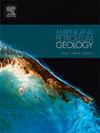Sedimentation-controlled double BSRs and implications for paleo hydrate dissociation in the Shenhu area, south China sea
IF 3.7
2区 地球科学
Q1 GEOSCIENCES, MULTIDISCIPLINARY
引用次数: 0
Abstract
Double/multiple bottom-simulating reflectors (BSRs) have been discovered worldwide, but their preservation and formation mechanism remain unclear because most studies are based on seismic data, lacking direct evidence like well logging data. This study introduces a novel well log-based interpretation of double BSR, suggesting that the secondary BSR (BSR2) is the interface between little residual gas and the overlying water-saturated sediment, and the free gas is trapped by capillary seals. The BSR2's amplitude is influenced by the nearby porosity, with lower porosity resulting in stronger reflections. Seismic attributes reveal a dynamic process of hydrate cycle that hydrate dissociation occurs above BSR2, followed by gas migrate to form a new BSR1. The upshift of BSR2 is mainly controlled by sedimentation rate, which varies across different regions, leading to larger upshifts in areas with higher sedimentation rates. Moreover, BSR2's upshift is negatively related to the reflection magnitude of BSR2, because rapidly depositing sediments with higher porosity and lower percolation threshold allow lesser gas sealed beneath the BSR2. Our findings suggest that double BSRs are predominantly formed in muddy sediments under rapid geological events like rapid sedimentation. However, each BSR can be preserved as well as observed to indicate that the BSR has existed for an extended period of time during which the geologic environment has been relatively stable, e.g., low sedimentation rates. This detailed sedimentation-controlled BSR adjustment provides new insights for the interpretation of double BSR and the paleo hydrate dissociation.
沉积控制的双BSR及其对中国南海神狐地区古水合物解离的影响
双重/多重模拟底部反射体(BSR)已在全球范围内被发现,但由于大多数研究基于地震数据,缺乏测井数据等直接证据,因此其保存和形成机制仍不清楚。本研究提出了一种基于测井资料的双 BSR 新解释,认为次级 BSR(BSR2)是少量残余气体与上覆水饱和沉积物之间的界面,游离气体被毛细管密封所截留。BSR2 的振幅受附近孔隙度的影响,孔隙度越低,反射越强。地震属性揭示了水合物循环的动态过程,即水合物解离发生在 BSR2 上方,随后气体迁移形成新的 BSR1。BSR2 的上移主要受沉积速率控制,不同地区的沉积速率不同,沉积速率较高的地区上移幅度较大。此外,BSR2的上移与BSR2的反射幅度呈负相关,这是因为快速沉积的沉积物孔隙度较高,渗流阈值较低,因此BSR2下方封存的气体较少。我们的研究结果表明,双 BSR 主要形成于快速沉积等快速地质事件作用下的泥质沉积物中。然而,每个 BSR 都能被保存下来并被观测到,这表明 BSR 已经存在了较长时间,在此期间地质环境相对稳定,例如沉积速率较低。这种详细的沉积控制 BSR 调整为解释双 BSR 和古水合物解离提供了新的见解。
本文章由计算机程序翻译,如有差异,请以英文原文为准。
求助全文
约1分钟内获得全文
求助全文
来源期刊

Marine and Petroleum Geology
地学-地球科学综合
CiteScore
8.80
自引率
14.30%
发文量
475
审稿时长
63 days
期刊介绍:
Marine and Petroleum Geology is the pre-eminent international forum for the exchange of multidisciplinary concepts, interpretations and techniques for all concerned with marine and petroleum geology in industry, government and academia. Rapid bimonthly publication allows early communications of papers or short communications to the geoscience community.
Marine and Petroleum Geology is essential reading for geologists, geophysicists and explorationists in industry, government and academia working in the following areas: marine geology; basin analysis and evaluation; organic geochemistry; reserve/resource estimation; seismic stratigraphy; thermal models of basic evolution; sedimentary geology; continental margins; geophysical interpretation; structural geology/tectonics; formation evaluation techniques; well logging.
 求助内容:
求助内容: 应助结果提醒方式:
应助结果提醒方式:


